November 2014
By Tad Bradley
Uganda has been at the top of my must-visit list since I started travelling to Africa over 10 years ago. It’s a destination that has always intrigued me. But in my case, it wasn’t because of the gorillas and preponderance of primate species. What attracted me were the jagged peaks and conical volcanoes of the two mountain ranges that delineate the western border with the Congo. I’m a mountains guy. I grew up exploring the Cascade and Olympic Mountain ranges in Washington State and spent my 20’s traipsing around the White and Green Mountains of New Hampshire and Vermont. Fittingly, my first trip to Africa was to climb Mt. Kilimanjaro. And then I lived and worked as a guide leading hiking trips throughout the volcanoes of Guatemala’s highlands.
So it was the Rwenzori Mountains and Virunga Volcanoes which drew me to Uganda. And they did not disappoint. But beyond those spectacular mountain ranges, Uganda exceeded my greatest expectations for wildlife (both primates and game viewing), cultural opportunities and pure beauty.
November 15: Arrival into Entebbe
From Seattle, I flew Delta/KLM to Amsterdam and after a 3 hour layover, onward to Entebbe. KLM offers direct flights every day from AMS – EBB (Tues/Thurs/Sat direct, Mon/Wed/Fri/Sun with a short stop (same plane) in Kigale, Rwanda). The only drawback is the arrival into Entebbe is around 10pm, so if pax are starting their trip the following morning, that first night is pretty short. But it’s a relatively painless Africa flight, especially if your departure city has a direct flight to Amsterdam.
The arrival procedure at EBB was straightforward though slower than normal as all passengers were scanned for a temperature prior to customs. The required visa for Americans/Canadians is US$50, visa paid on arrival. Proof of Yellow Fever inoculation is also required though I wasn’t asked for it. Classic Africa Safaris senior guide Edward Kabagyo picked us up from the arrivals area and in 10 minutes we had arrived at Karibu Guesthouse.
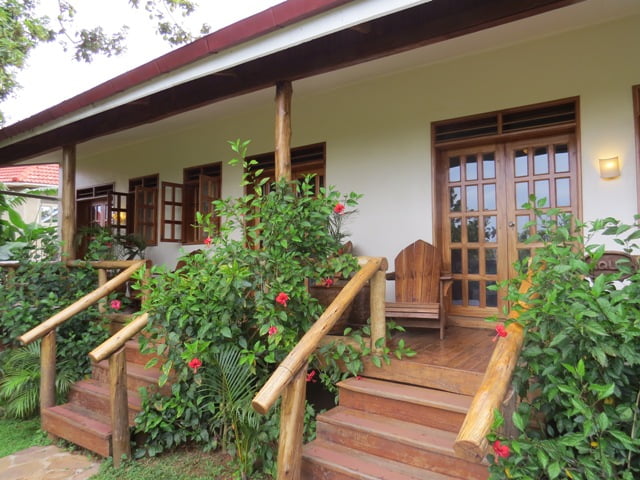
KARIBU GUESTHOUSE COTTAGES
Karibu is wonderfully homey B&B tucked into the leafy hillside above Lake Victoria. It has seven uniquely decorated and very comfortable rooms – three newer cottage rooms and four in the main house – all are about the same size. The cottage rooms have nicer bathrooms and a small deck and sitting area in front which looks over the lush gardens. Known for its Mediterranean-style daily dinner menu, we were too late in arriving to experience the food, though all reports are that it is excellent. If our breakfast was any indication, the food is not only delicious but also plentiful! There is an open-air veranda restaurant on the main floor and an upstairs terrace with views of the gardens and sunsets over Lake Victoria. Karibu is an excellent mid-level property for repeat Africa travelers or those pax who like homey, boutique-style accommodation.
For newbie Africa travelers, luxury pax or those who prefer a more traditional hotel experience, the Protea Hotel Entebbe is a great option. Newly opened in 2012 (and with an expansion in progress), the 73-room hotel sits directly on the shores of beautiful Lake Victoria and features extensive landscaped gardens and a private white sand beach! All of this and it’s just a 5 minute drive from the airport. The deluxe rooms are recommended for their gorgeous views over Lake Victoria. For an overnight stay on arrival, it would be hard to complain about the Protea.
While Kampala is only 35-40K away, CAS generally recommends guest stay in Entebbe to avoid the 2-3+ hour drive into the capital and its horrendous traffic. For those who must stay in the city, Lyndsay reviewed the Kampala Serena and the luxury boutique hotel, Emin Pasha, in her trip report from November 2011: Lyndsay’s 2011 Uganda trip report.
NOTE: Before I get too far into the report, a bit more about our guide Edward. I cannot say enough about his professionalism, knowledge, character and dry sense of humor. He kept us on a tight schedule logistically (as necessary) all while managing to deliver an incredible safari experience. We felt very lucky to be traveling with such a tremendous guide and a genuinely wonderful human being.
November 16: Drive to Murchison Falls
We departed Entebbe the following morning for the full day drive to Murchison Falls National Park (MFNP). While those guests skipping MFNP and going straight to Kibale or Queen Elizabeth National Park can skirt Kampala and avoid the worst of the traffic, the road to Murchison can’t entirely avoid the city. Lucky for us, it was Sunday so the roads were relatively traffic free and we made it through the city in short order. During the rest of the week, CAS guides will take the ring road on the outskirts of the city to avoid the worst of the traffic in the city center.
NOTE: AeroLink Uganda has 3 flights per week (We/Fri/Su) from Entebbe to Murchison Falls for those guests who want to avoid the full day drive. However, a CAS vehicle must dead-head from Entebbe to meet the guests for activities in MFNP and then to continue onward to Kibale.
The road to MFNP is paved and in good condition for the first 200KM to Masindi, about 3.5-4hrs from Kampala. We made a lunch stop at the Kabalega Diner, a local restaurant and rest stop located off the highway, about 30 minutes before Masindi. The food was good and plentiful, nothing spectacular but perfectly acceptable for a short lunch break. There was a nice terrace and most importantly, clean bathrooms! (NOTE: Clean, non-squat toilet bathrooms in Uganda are at a premium and as a destination that requires a lot of driving, this can be an issue, especially for female travelers. Often a bush toilet is preferable).

BUDONGO FOREST ROAD THROUGH MURCHISON FALLS NP
A further thirty minutes on gravel roads past Masindi, and we reached the park entrance. From the gate, it’s another 85 KM and 2.5 – 3 hours on unpaved roads (depending on road conditions) to reach the Murchison Falls and the various accommodations located along the Nile River. This drive is through the lush Budongo Forest, home to one of the largest population of chimps in Uganda (chimp trekking is very good here with a high success rate), many varieties of monkeys, lots of baboons and a wide variety of birds (we also spotted a very large monitor lizard and a puff adder snake!). It’s an enchanting place and thanks to the incredibly dense vegetation that envelops the road, it feels as if you are driving through a tunnel of verdant flora.
We arrived at the top of the Murchison Falls in the late afternoon. Guests would generally not visit the falls on their arrival to the park but rather head to their accommodations to enjoy sundowners and settle into their rooms before dinner. But of course we were on a whirlwind exploratory tour! The top of the falls are an impression for both the eyes and ears, as the thunderous, furious Nile is forced into narrow gorge, only 23 ft wide, and then explodes into a fire hose of frothing white water as it plunges 141 ft to the pool below. The raw and violent power of nature is on display as you stand perilously close to this churning mass of white water (340 cubic meters of water cascades over the falls per second)! The view is from the top is also spectacular – the narrow canyon and frothing falls framed by misty rainbows and the late afternoon sun as it glistening off the tranquil Nile downstream. And unlike Victoria Falls (or Iguazu Falls or Niagara Falls for that matter), at Murchison Falls there aren’t a crowd of annoying vendors trying to sell you knickknacks or knockoff curios. In fact, there wasn’t a single vendor. Just a park ranger on duty. Refreshingly unspoilt.
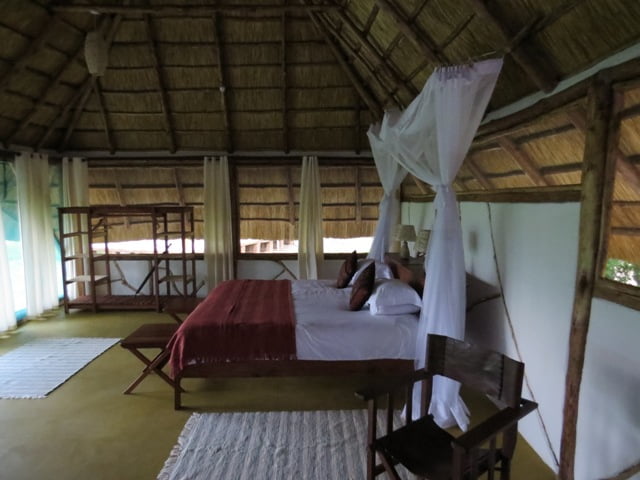
BAKERS LODGE STONE AND THATCH COTTAGE
After soaking in – literally! – the sights and sounds of the falls, we made a quick stop at Bakers Lodge, a new Murchison property opening in December 2014. The lodge is located downstream from Murchison Falls along the banks of the Nile, set amongst shade trees in a large grassy area bordered by wetlands teeming with birdlife. It will have six rooms open by mid-December and eventually ten units in total. Accommodation is in spacious raised stone and thatch chalets, with a screened open front with river views. Some chalets are large enough to sleep four so this would be a great family option. The en-suite bathrooms are also roomy and feature a double vanity and large stone tiled shower. There is a small sitting area/deck in the front. Power and hot water are both solar.
The main lodge is an open air, raised thatched structure facing the river with a bar, central lounge and dining area and several levels of view decks. During our visit it felt overly large and not very cozy but that was probably due to the lack of furniture and people. There is still a lot of work to do on grounds – the crushed rock pathways connecting the lodge and chalets were under construction and the landscaping was still a work progress. Bakers will be an excellent up-market option, maybe the best option in MFNP once it opens.
We continued on to the Nile Safari Lodge, located just outside the park gate in a private concession along the river. The lodge is situated on a high bank above the Nile and the elevated position offers beautiful views downstream and toward the Nile delta. We arrived just as the sun was setting – spectacular! The main lodge area has a covered dining area/bar and small lounge, several view decks with comfortable seating and a fire pit. It was very cozy with lots of ambience.
There are twelve units – six log cabins and six tents, all en-suite and which face the river with private viewing decks. I stayed in one of the log cabins, which are entirely wood paneled on the interior, which isn’t itself a problem but coupled with the tired bedding, clear plastic shower curtain and hole-y mosquito net, it all felt dated and in need of some TLC. The bathrooms all have bucket showers and the water was very hot! Several of the tents have outdoor showers, though all the cabins have indoor showers. There are charging points in rooms, though they only work when the generator is on, which is in the early morning and then late afternoon until around 10pm.
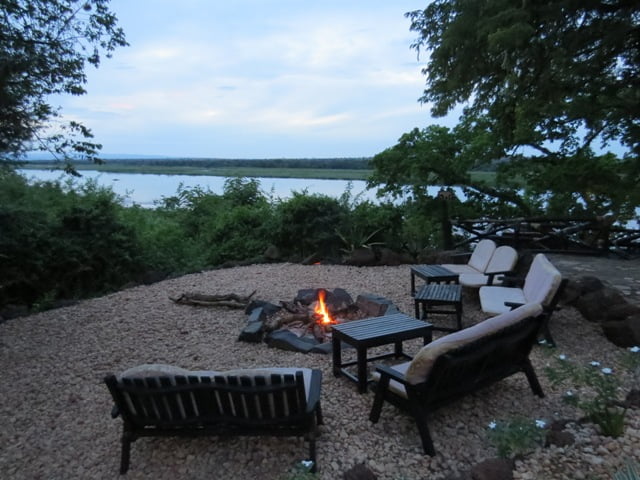
BEAUTIFUL VIEWS FROM THE NILE SAFARI LODGE
The biggest issue with the cabins was the visitors at night – bats! Apparently it’s a problem they have been trying to address by patching access points in the thatched roofs but clearly there is still work to be done. The staff did warn us to keep the doors closed so the bats didn’t get in, which we all did religiously. Clearly they were finding other ways of entry. I ended up sleeping very well as huge thunderstorm blew in around midnight and it rained, very hard, until 7am. The sound of the rain on the thatched roof was glorious and it drowned out the sound of the bats! The CAS team will be following up with the management regarding the bat issue and what additional steps can be taken.
The main lodge and cabins are connected by stone pathways through the lush native forest along the river. There is a great swimming pool with nice views of the river. The all-local staff was very attentive and very kind. The food was fine, nothing spectacular but after our long day of driving, we were more interested in toasting our first day in Uganda with a Nile Special beer anyway!
I would consider Nile Safari Lodge to be best for adventurous mid-range pax, though depending on rates, Bakers will give them a run for their money. The bat problem is obviously an issue, even more so than the tired cabins. But both should be addressed if they want to compete with the new kid down the block/river. The tents were pretty basic but wouldn’t have the bat issues, so I’d request a tented room until the bat situation is resolved.
November 17: Murchison Falls National Park, Nile Diver delta
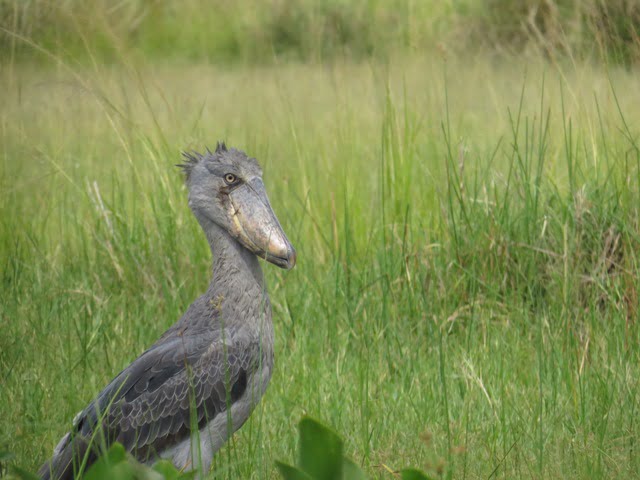
A SHOEBILL! THE WILDLIFE GODS WERE ON OUR SIDE ON THIS DAY
The following morning we embarked from the lodge for a cruise downstream to the Nile delta where the river empties into Lake Albert. CAS only uses the smaller boats (from 5-15 pax maximum) for both scheduled and private cruises of the Delta and those to the Falls (there are some very large (30-50 pax) booze cruise type boats, a-la Victoria Falls, which cruise up to the Falls). Sunset, sundowner, cheese and wine or early morning sunrise trips are all offered as well as birding specific cruises on request.
The biggest attraction of the delta is undoubtedly the Shoebill, one of the few remaining habitats of this rare bird. But the delta cruise is a birders paradise, Shoebill or no Shoebill. Our checklist included: Crowned Cranes, Pied Kingfisher, Egyptian Geese, Jacana, Goliath heron, Yellow Billed Kike, Darters, African Skimmers, Common Squacco Heron, White Face Whistling Duck and great flocks of Egrets, to name just a few.
In addition to a wide variety of birds, we also spotted black and white colobus monkeys, nile crocks, hippos galore, waterbuck, kobs and two oribi antelope, a mother and faun. Because November is at the tail end of the rainy season, we didn’t see any large game along the banks of the river but in the dry months (December – February and June – August), it’s very common to large herds of elephant, buffalo, and even Rothschild giraffes drinking along the river banks (MFNP is one of only two parks in Uganda with giraffe, the other being Kidepo Valley NP). The best game viewing is on the north side of the river in the Buligi area of the park. To explore this area, Edward planned to meet us with the CAS vehicle on the banks of the delta and then we’d game drive back to Paraa Lodge for lunch. However, the heavy rain from the night before meant the roads in the park were nearly impassable so the plan was scrapped and instead, we continued our cruise winding through the delta’s many channels and islands of papyrus until we reached Lake Albert. The delta and the northern bank of the Nile are really beautiful and as there are no villages or lodges in this part of the river and so it feels very wild and untouched.
When we had asked Edward that morning what our chances were to see one, he laughed and gave a classic guide answer – “Probably about 50/50.” It’s certainly no guarantee and honestly I didn’t expect that we’d get lucky. But just as we had resigned ourselves to a Shoebill-less cruise, our guide gestured excitedly and pointed to a spec on the riverbank, a good 150-200 yards away, “A Shoebill!” he exclaimed. As the boat glided closer, the grey spec came into focus – there was the Shoebill. It was a striking bird and quite a bit larger than I expected. It moved with a deliberate strut and this, along with its spiky “hairdo” reminded me of Mick Jagger striding across the stage. At one point, the Shoebill took flight and displayed its impressive wingspan and then alighted just down the river. We were able to spend about 10-15 minutes floating and observing it. Definitely an impressive bird and our Uganda wildlife checklist was off to an excellent start!
We arrived back at the Nile ferry crossing around noon, a very enjoyable four hour cruise. Edward picked us for the short 3 minute drive to Paraa Lodge, prominently perched on a hill just above the river. Paraa is one of the original hotels in Uganda, built in 1954. It is a traditional large safari lodge with two floors of 54 rooms, all of which have a small balcony or patio which looks out at the swimming pool or a grassy knoll and the Nile beyond. The standard rooms were what you’d expect in a relatively modern hotel – not a ton of character but perfectly nice, medium sized, comfortable bed and what looked to be recently upgraded bathrooms. Paraa stocked both shampoo and conditioner, which isn’t an expected luxury in many accommodations in Uganda.
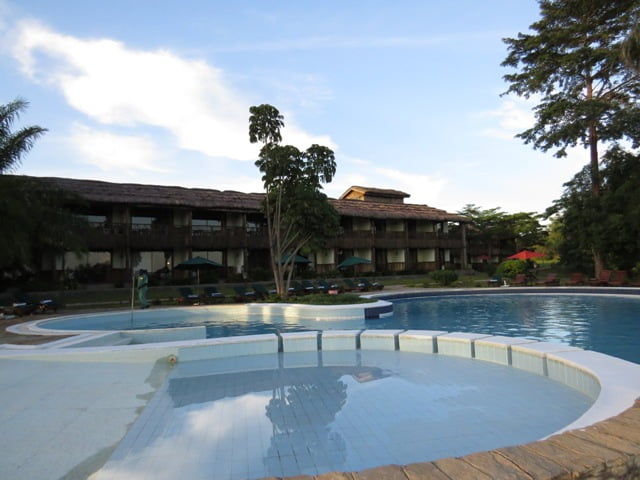
PARAA LODGE
There are also three safari tents located a short walk away. They aren’t anything special and given their complete lack of shade and prominent location on the hill, I’d be worried about cooking alive during the hotter parts of the year with the sun beating down on them! If you have pax who want a tented experience, send them to Nile Safari Lodge. There is also the Queens Cottage, a private 2 bedroom house which would be good for families as it has AC, lots of room and a large grassy yard.
While there are 54 rooms, the main lodge is very spacious with many different lounge areas so I don’t think it would ever feel particularly overcrowded. The style is very colonial which can either be charming or off-putting. At Paraa, it felt mostly charming. The staff was wonderful.
We had lunch on the veranda of the main dining room. The view is beautiful, looking out over the Nile and the Budongo Forest beyond. The food was good if not spectacular. I enjoyed my Tilapia with the ubiquitous “vegetable rice.” One of my travelling companions had the beef fillet and said it was only okay.

After lunch, we headed back out on the Nile, this time upstream toward Murchison Falls. Again, a birding bonanza (including a large nesting colony of Red Throated Bee Eaters) but we also came across many warthogs, bushbuck, waterbuck, several monitor lizards, bachelor buffalos, a solitary young male elephant, many hippos and a plethora of crocks, including a massive 10ft, 400-600 kg beast!
As we approached the falls, the river narrowed and the velocity of the water rushing downstream started to increase, quite substantially, creating a number of whirlpools and standing waves in places. Our skipper expertly navigated our launch to a small island in the middle of the river, which offered some protection from the torrent of water and a good view of the falls beyond. We were probably a good – mile way but given the violent nature of the water, this was the closest we could safely go. But even from this distance, the tremendous raw power of the falls was on display!
There is a small dock on the south side of the river which leads to a trail to the top of the falls. We didn’t make this climb but apparently it’s a bit of challenge, requiring some scrambling, but the views of both Murchison and Uhuru Falls (the smaller waterfall just west of Murchison, which was created in an especially high flood season in 1962) are spectacular.
Another interesting historical and literary monument is just downstream from the falls. On January 22, 1954 a private airplane carrying Ernest Hemingway and his wife on scenic tour of the falls, crashed into the riverine forest after clipping a telegraph wire strung across the nearby Fajao Gorge. Hemingway and his wife survived and were rescued the following day, only to have their evacuation flight also crash! Hemingway was injured but not seriously. But apparently they had enough of small planes, and crashes, and drove the 200KM back to Entebbe! Here’s a great article from The New Yorks Times detailing their adventures and mishaps in the Murchison Falls area.
We returned to Paraa for the evening. The elevated location made for a spectacular sunset over the Nile and the Blue Mountains in the Congo beyond.
A few additional photos from our day exploring the Victoria Nile:
[Best_Wordpress_Gallery id=”2″ gal_title=”Uganda Trip Report 2014: Entebbe, Murchison Falls and Kibale Forest”]
November 18: Drive to Kibale

SUNRISE OVER THE VICTORIA NILE
After a good though hurried breakfast, we departed early from Paraa so we could make the 7am ferry across the Nile. The “ferry” is more of a long barge which fits approximately 8-10 vehicles. Only the drivers can stay in the vehicles, passengers must walk on. The ferry crosses every 1-2 hours from sun up to sun down but with our long day of driving ahead, we didn’t want to miss the 7am crossing! The Nile was memorable this morning with the sun rising over the misty water.
It’s a full day’s drive (8+ hours) between MFNP and the Kibale forest area, most of which is on unpaved roads. Edward had hoped to begin our drive on the road paralleling Lake Albert that offered some historical monuments and nice viewpoints over the lake. But he had received reports that due to the recent rains that the road was in bad shape so instead returned the same way as we came, via the Budongo Forest. This drive reinforced two things for me about Uganda: it is very densely populated and extraordinarily beautiful (and we hadn’t even seen the mountains yet!). We drove through Masindi, Hoima and a plethora of smaller villages and homesteads along the way. Edward kept us engaged stories from his childhood growing up in Hoima and the fascinating history of Uganda’s tribal kingdoms. Hoima is the seat of the Kingdom of Bunyoro. Outlawed and disbanded by the 1967 constitution and further marginalized by Idi Amin, the kingdoms were re-established in 1993 and enshrined as Uganda’s 1995 constitution. Though fully recognized by law, they are not sovereign politically. However, they do have considerable political influence and the royalty are highly respected by the people.
Our road trip also cemented for me how critical well-maintained, comfortable and reliable vehicles are when on a Uganda driving safari. And the CAS vehicles lived up to their stellar reputation! CAS maintains its own vehicle fabrication and coach-building workshop in Entebbe, where our vehicles are custom designed and built to provide the maximum in client comfort and reliability. Each vehicle is checked-out and serviced after each and every trip, minimizing the risk of a future breakdown.

CUSTOM-BUILT 8-SEAT LAND CRUISER AT CAS VEHICLE FABRICATION WORKSHOP IN ENTEBBE
As if to further emphasize this point, we stopped to pick two wayward travelers whose vehicle had broken down on the road between MFNP and Kibale (This isn’t something we would normally do with clients but we had room and Edward asked us if it was okay. The situation with their vehicle sounded dire so we readily agreed to rescue them). They immediately remarked about how much more comfortable and smooth our vehicle was. And indeed, even on the roughest roads, our CAS Land Cruiser provided a relatively gentle ride.
All CAS vehicles have comfortable bucket seats (all window seats), large windows and pop tops for game viewing, and come equipped with a cooler box full of water, a charging station for camera batteries and phones, umbrellas, bean bags and blankets.
Generally on this drive, pax would make a picnic lunch stop en-route (there are several options for this). But Edward noted that CAS is investigating local restaurants are possible lunch options because due to amount of driving, picnic lunches are a common occurrence and they can get a bit tiresome (and depending on the accommodation, the quality isn’t as reliable).
From the Hoima to Kyenjojo, the vistas only got better. The rolling hills seemed to grow anything and everything – lush fields with more shades of green that one can imagine. From Kyenjojo the road was once again paved, winding its way through the endless fields of manicured green tea plantations, all the way to Fort Portal, the gateway town to the Kibale Forest.
We arrived at Kyaninga Lodge around 4:30pm. Kyaninga Lodge is located just a few kilometers from Fort Portal but due to the very rough access road that climbs the hill to the lodge, the drive takes 20-30 minutes. It was one of the roughest roads we experienced in Uganda but that said, it was absolutely worth the effort (word is that the road will soon be graded which will help tremendously).
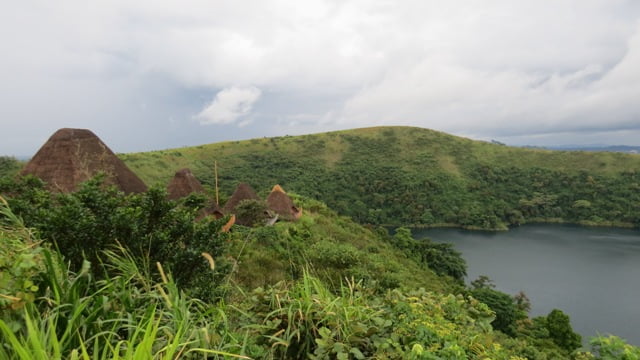
KYANINGA LODGE LOG CABINS PERCHED ABOVE THE CRATER LAKE
Kyaninga is one of the most uniquely designed properties I’ve ever experienced anywhere in the world. Its location is absolutely stunning. And the story of its construction is simply amazing (Short version: Englishman Steve Williams stopped at this lake en-route to trek with the gorillas and was so captivated by the location, he envisioned building a luxury lodge in that very spot. Six years and over a thousand hand carved logs later, Kyaninga opened for business!).
The main lodge and its eight log cabins are situated on platforms which are strung out along the rim of the Kyaninga crater lake and connected by a series of staircases and raised walkways. All the cottages overlook the lake with the backdrop of the spectacular Rwenzori Mountains, aka the Mountains of the Moon. They are very spacious and feature a massive bed, small sitting area with handcrafted wood furniture, and a large private deck with several lounge chairs for taking in the beautiful view. The bathroom was probably the nicest in Uganda – double vanity with marble countertops, claw bathtub, glass walled shower and a large window overlooking the lake. Power is largely solar with a backup generator primarily for supplementing the solar hot water heater (and for the guest who must use a hair dryer!). The room also had three plugs for charging, including one with a built-in international adaptor. It’s the little touches that often impresses the most. The cabins are well spaced and positioned in a way that you can’t see your neighbor, so they feel very private.
The main lodge is at the apex of the crater rim and therefore it requires climbing a lot stairs to access it from any of the cottages. It has a warm, ski lodge feel, with a large stone fireplace, several lounges and a bar, cozy lofts and a dining area with great views of the lake and the mountains. It’s not fancy by any means but exudes comfort and warmth, especially when the fire is going and the rain is pouring down like on this afternoon! Wifi is also available.
The lodge opens up to a series of view decks, a nice sized pool and two private grass terraces, nestled into the hillside gardens below the lodge (They have plans to build a small spa in the lower terrace).
The lodge offers a number of activities, both on their grounds and in the surrounding areas. The self-guided crater walk takes around 1.5 hours and navigates the rim of the crater lake, offering beautiful views of the lodge and the surrounding fields, large ash cone hill and mountains. A three hour guided forest walk will take guests into the lush native forest below the lodge and down to the crater lake. The lake is bilharzia free and very warm (75 degrees F!), so it’s great for swimming. There is a dock and swimming raft. The lodge grounds also feature Uganda’s only grass tennis court and croquet lawn, and an organic garden and orchard which provides fruits and vegetables for the lodge kitchen.
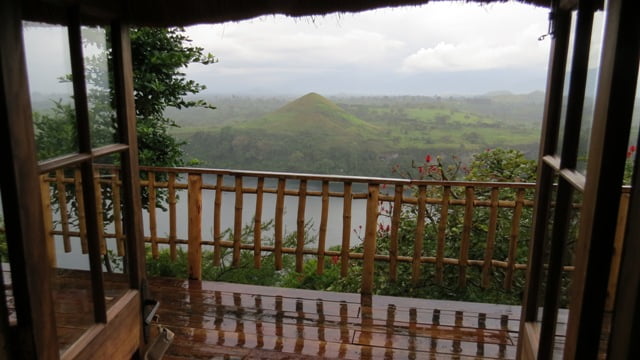
KYANINGA CABIN VIEW
The highlight of our stay, even eclipsing the location and the view, was the staff. Matt, the manager, is originally from the UK and has been with Kyaninga since it opened. Unfortunately, he was recovering from Malaria so he wasn’t able to meet us but he sent his regrets and bought us a bottle of wine! The rest of the Kyaninga team, to a person, was excellent. We were all very impressed with the confidence, humor and knowledge of the local staff. They have been well trained and clearly take pride in the lodge.
The food was also excellent. The beef and cucumber carpaccio starter was delicious and the main course of bacon wrapped chicken with served with garlic mashed potatoes and a honey glaze sauce was perfect comfort food on cold, wet night (the honey is sourced from their own honeycombs). But the highlight was the sticky date cake for dessert! Breakfast was also very good. I had eggs florentine made spinach from the lodge garden.
Overall Kyaninga Lodge was a charming, welcoming and stunningly beautiful place. It is a great choice for seasoned travelers looking for unique accommodation or for those active travelers who have time to stay at least two nights and take advantage of many activities in the surrounding area. Obviously the mobility challenged will struggle with this property given the amount of stairs.
November 19: Chimp Trekking in Kibale Forest
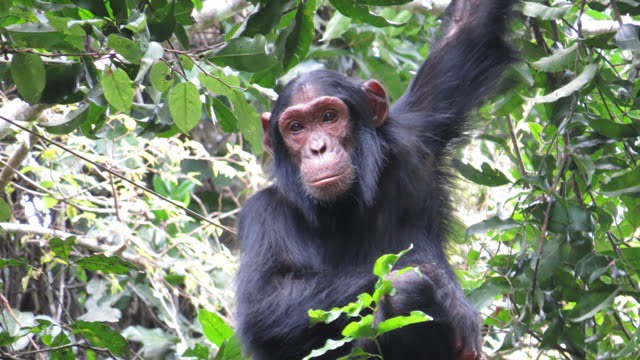
We awoke to a brilliant sunrise illuminating the Mountains of the Moon. Kyaninga Lake was glass still reflecting the mountains, forest and brilliant green agricultural fields above. We left just after breakfast for Kibale National Park, passing through the many picturesque tea plantations that blanket the rolling hills bordering the forest. The drive from Kyaninga to the park headquarters takes at least an hour but it is very beautiful. After arriving at the park headquarters, we were briefed by our trekking guide and then drove a short way to the starting point of our trek. Each group of six guests is accompanied by a guide, assistant tracker and armed UWA park ranger. Initially, we didn’t have to do much trekking as the alpha male of the largest troop in the area was perched high in the forest canopy just above our vehicle, enjoying his breakfast in the sun. We literally had to walk about 20 steps to see him. On one hand, it was a bit anti-climactic as I expected to have to work and actually track the chimps to see them. On the other hand, there was the alpha male of the 120-member strong troop, high up in the forest canopy, enjoying his breakfast in the sun! We spent about an hour watching, taking picture and waiting for the male to descend from the tree and lead us to the rest of the troop. And then the adventure began!
The alpha male took us on a wild goose chase, deep into the forest. We followed him for about 20 minutes and then he disappeared into the thick under brush. Smart guy, he led the humans into the densest part of the forest and then gave us the slip! But shortly thereafter, our guide received a call from other trackers nearby that several groups of chimps had been located and were on the move. So we continued our trek, farther into the forest. After about 30 minutes of walking, we found the larger troop, spread out into several smaller groups. The first group of four or five were all lounging on the forest floor. We were able to get quite close – 10-15ft – to several of the older chimps, who were more habituated to nosy humans! Two chimps were comfortable enough to continue grooming each other while we watched. We continued onward and finished our chimp encounter with a group of three or four playing and eating about mid-canopy in the forest. A truly amazing adventure.
The trekking wasn’t especially physically taxing, as the terrain is relatively flat in Kibale. But there were times when following the alpha male that we were moving at a very good clip through dense forest, climbing around, over and under large branches and dodging smaller vines and sticks. This definitely got my heart beating! And while it was warm and humid, when out of the sun and protected by the canopy, the heat wasn’t unbearable by any means. Long sleeves and long pants are critical and gloves are not a bad idea. I also wore gaiters, which were a big help against the underbrush, muddy parts of the trail and any safari ants!
Watch the video below to get a sense of our morning experience tracking chimps in Kibale:
After our adventures in chimp tracking, we left the park for a short visit to Tinka’s homestead. Tinka is local community leader and he offers a wonderful fresh and organic traditional buffet lunch for visitors, either before or after chimp trekking. Lyndsay provided a great description in her November 2011 trip report: Most of our groups who visit Kibale have lunch at Tinka’s home and enjoy traditional Ugandan food. Thanks to Tinka’s involvement with community development and wildlife conservation, he has traveled the world and learned to appreciate the cultural connectivity that a meal allows for and aims to provide that experience at his home. Tinka has also spearheaded the development of the Bigodi Swamp walk adjacent to the community. The swamp walk is ideal for birders, provides great primate viewing opportunities (no chimps here) and is an excellent way to support the local community.
Tinka has a gentle, kind and wise demeanor and we were all taken with him. Unfortunately, we weren’t able to stay for lunch as more site inspections awaited us!
We made a short stop at Primate Lodge which is located inside the National Park and just a stone’s throw from the park HQ. It is a good option for those who plan to do multiple chimp treks or are serious primate fans, as we spotted a several variety of monkeys on the grounds of the lodge itself. Primate has eight tents and seven cottages set within the dense Kibale Forest. The safari tents are raised on a wooden platform with a grass-thatched roof and a small veranda. They were much brighter and had more character than the cottages. There is also a Treehouse located about 800m/10 minutes from the main lodge which overlooks a forest swamp which is a very popular drinking hole for forest elephants in the dry season. It has very basic accommodation and washing facilities are located on the forest floor, similar to a sleepout experience.
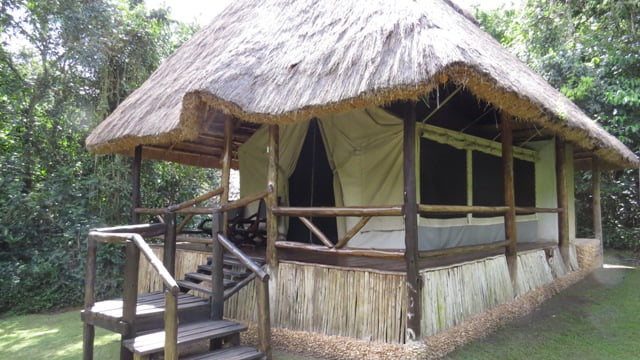
PRIMATE LODGE TENT
We continued out of the park and to Ndali Lodge for a late lunch. Like Kyaninga, Ndali has a stunning location perched on a ridge overlooking a serene crater lake on one side and the Rwenzori Mountains on the other. We were very warmly welcomed by Ndali’s gregarious owners Aubrey and Clare and their two rambunctious dogs, Bertie and Polly. They soon had a glass of rose in our hands and their easy manner made us feel right at home. The welcome we received there was without equal in Uganda. It is clearly a labor of love.
We enjoyed a tasty lunch of homemade fish and chips (the UK roots run deep here!) on the patio overlooking the crater lake. Aubrey told us the story of his late father who built Ndali and his family’s history in Uganda beginning with his grandfather, who arrived in the country during a month’s long Africa exploration after fighting in WWI. He never left.

CRATER LAKE VIEW FROM NDALI LODGE
The main house has several rooms, connected by two covered open passageways. There is a lounge and sitting area with an extensive bar; a formal entry/foyer and a dining room. The house is bright, airy, and comfortable with a warm, colonial country inn feel to it. Artwork and photos of the Price family are displayed on shelves, including Aubrey and Clare’s wedding photos. Touches like this and the general welcoming nature of the place, makes it feel as if you are visiting old friends rather than staying in a hotel. At night, the lodge is light only by candles (there is no electricity) which I imagine creates a captivating and romantic setting.
Ndali has eight stone and thatch cottages all of which face west and offer a panoramic view of the lush rolling hills and the spectacular Mountains of the Moon beyond. The cottage d’cor was a bit too English B&B style for my taste but cozy nonetheless. The bathrooms were pretty small though the large soaking tub offered a tremendous view of the valley below and mountains beyond! Another pet peeve – the shampoo and conditioner were half used store bought brands which seemed very odd for an up-market lodge. A simple solution would be to use ceramic dispensers with “Shampoo” and “Conditioner” stenciled on the bottles. The cottages have solar power and a wood hot water boiler.
There is a nice pool with view of Rwenzoris, plus a sauna and massages are offered (in room service). Aubrey excitedly told us that they have purchased kayaks for excursions on the crater lake which should be arriving soon. There is bilharzia in lake however, so pax should be aware of this and swimming is discouraged.
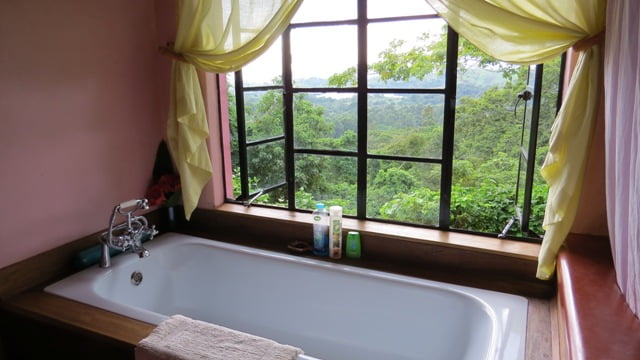
BATH WITH A GORGEOUS VIEW!
Ndali is about 45 min � 1hr from the Kibale Park HQ, so only slightly closer than Kyaninga. It’s hard to compare Kyaninga and Ndai as they are so different and uniquely special in their own way. I liked the homey feel of the main lodge at Ndali but I preferred Kyaninga’s log cabins (especially the bathrooms!). For the mobility challenged, older or more traditional traveler Ndali is the better choice. For the adventurous, experiential traveler, I’d pick Kyaninga. Either way, it’s hard to go wrong. Both properties are gems.
Our Uganda journey continued that afternoon to Queen Elizabeth National Park. Look for part two of my trip report featuring our adventures in QENP and Bwindi Impenetrable National Park coming soon!
More photos from Uganda with Classic Africa Safaris on our Facebook page:
Tad’s Uganda adventures in 2014
Lyndsay’s Uganda adventures in 2013
Lyndsay’s Uganda adventures in 2011



Leave A Comment
You must be logged in to post a comment.